As devoted pet parents, we constantly strive to provide the best care for our beloved canine companions, and a significant part of that care revolves around their diet. The dilemma of [what foods dogs can and can’t eat] is a question that frequently puzzles many, given that what’s good for us isn’t always safe for our furry friends. Understanding the intricate differences in canine digestion and metabolism is paramount, as many common household foods can range from mildly upsetting to fatally toxic for dogs. Pet poisonings are a stark reality, with hundreds of thousands occurring annually in the United States alone. While not all incidents are food-related, everyday human foods are a major contributor, making knowledge a crucial shield for your dog’s safety. This comprehensive guide aims to arm you with essential information, serving as your ultimate “cheat sheet” to navigate the culinary landscape for your dog, ensuring they remain healthy, happy, and far from harm. Whether you’re curious about [what are some human foods that dogs can eat] or need to know precisely which items to keep out of reach, this resource will clarify the complexities of canine nutrition.
Understanding Canine Digestion: Why Some Human Foods are Toxic
The fundamental difference between human and canine digestive systems is the primary reason why dogs metabolize certain substances differently, rendering many human foods toxic for them. While our bodies are equipped to process a wide array of ingredients, a dog’s physiology is unique, often lacking the enzymes or metabolic pathways needed to safely break down certain compounds. This disparity means that substances that are benign or even beneficial for humans can quickly become dangerous, accumulating to toxic levels in a dog’s system.
The Science Behind Food Toxicity in Dogs
For instance, compounds like theobromine and caffeine found in chocolate are metabolized much slower by dogs than by humans. This delayed processing allows these substances to build up rapidly, potentially leading to severe health complications and even death. Similarly, while the fleshy parts of fruits like cherries are generally safe for humans, the pits, stems, and leaves contain cyanide. Although small amounts might not be immediately lethal, ingesting large quantities can be problematic due to cyanide’s interference with red blood cells’ oxygen-carrying capacity. Moreover, the pits themselves pose a physical hazard, being difficult for dogs to digest and potentially causing gastrointestinal obstruction or discomfort, such as diarrhea.
Factors Influencing Toxicity Levels
It’s also crucial to understand that food toxicity can vary significantly based on several factors, including a dog’s size, breed, and overall health condition. A small dog, for example, will be more susceptible to the effects of a toxic substance than a large dog consuming the same amount, simply due to their lower body weight. Certain breeds may also have genetic predispositions or sensitivities to specific compounds. Furthermore, a dog with pre-existing health conditions, such as kidney disease or pancreatitis, may react more severely to certain foods. This complexity underscores the importance of always consulting your veterinarian if you have any doubts about whether a particular food is safe for your dog. For more detailed information, exploring resources on [what human food can dogs eat and not eat] can provide valuable insights.
Dangerous Delicacies: A Comprehensive List of Foods Dogs Cannot Eat
Many household foods, seemingly innocent to us, can be incredibly dangerous—and often toxic—to dogs. It’s vital for pet owners to be aware of these common culprits to protect their furry family members. While this list is extensive, it’s essential to remember that it’s not entirely exhaustive, and vigilance is always key.
1. Alcohol
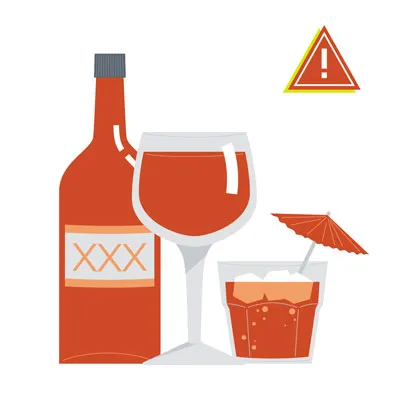 Dog sniffing an alcoholic drink glass, illustrating danger of alcohol for pets
Dog sniffing an alcoholic drink glass, illustrating danger of alcohol for pets
Alcohol, in any form, is highly dangerous for dogs. Due to their smaller body size and different metabolism, even tiny amounts can have severe, potentially fatal effects. Alcohol poisoning in dogs mirrors human symptoms, including vomiting, disorientation, breathing difficulties, tremors, and in severe cases, coma or death. The risk is significantly higher for smaller breeds, as their systems are overwhelmed much faster. It’s crucial to keep all alcoholic beverages and products containing alcohol (like certain baked goods or medicines) completely out of your dog’s reach.
2. Apple, Apricot, Cherry, and Plum Seeds/Pits
 Various fruit seeds and pits, highlighting the danger of apple, apricot, cherry, and plum pits to dogs
Various fruit seeds and pits, highlighting the danger of apple, apricot, cherry, and plum pits to dogs
While the fleshy part of an apple is a safe and healthy treat, the core and seeds are not. Apple seeds contain cyanide, a potent toxin. While small amounts might not be immediately harmful, consistent exposure or ingestion of a large quantity can lead to cyanide poisoning. Similarly, the pits from apricots, cherries, peaches, and plums also contain cyanide. Symptoms of cyanide poisoning include vomiting, irregular and rapid heart rate, seizures, coma, and even death, resulting from the red blood cells’ inability to effectively carry oxygen. Always remove all seeds and pits before offering these fruits to your dog.
3. Avocado
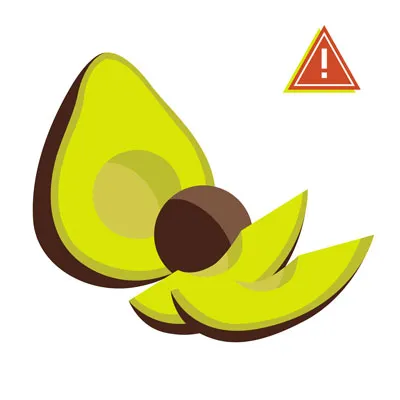 Whole and sliced avocados, cautioning against feeding them to dogs
Whole and sliced avocados, cautioning against feeding them to dogs
Avocados are generally not recommended for dogs. They contain a fungicidal toxin called persin, which can cause vomiting and diarrhea in some animals, particularly birds and rodents. While dogs are generally more resistant to persin than other species, the risk is still present. More concerning, however, is the large pit. An intact avocado pit can cause a dangerous gastrointestinal obstruction, especially in smaller dogs, requiring immediate veterinary intervention. Therefore, it’s safest to keep avocados away from your canine companion.
4. Broccoli
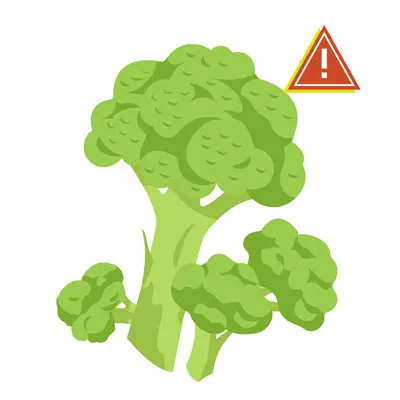 Fresh broccoli florets, indicating potential harm to dogs in large doses
Fresh broccoli florets, indicating potential harm to dogs in large doses
Broccoli contains isothiocyanates, compounds that can cause mild to moderate gastrointestinal irritation in dogs, especially in very large doses. While a very small, occasional piece of plain, cooked broccoli might be acceptable for some dogs, it’s generally best to avoid it due to the availability of many other unequivocally safe and healthy vegetable alternatives. Additionally, raw broccoli stalks can pose a choking hazard or become lodged in a dog’s throat, leading to an obstruction.
5. Caffeine and Coffee Grounds
 Coffee beans and grounds, illustrating the danger of caffeine to dogs
Coffee beans and grounds, illustrating the danger of caffeine to dogs
Caffeine, found in coffee, tea, energy drinks, and some medications, contains methylxanthines. These stimulants are highly toxic to dogs and can cause a range of severe symptoms, including restlessness, hyperactivity, vomiting, diarrhea, tremors, seizures, and potentially fatal cardiac arrhythmias. Even small amounts of coffee grounds or highly caffeinated drinks can lead to a rapid increase in heart rate and severe neurological distress. It’s imperative to keep all caffeine-containing products securely out of your dog’s reach.
6. Chicken & Turkey Skin, Ham, & Other Fatty Cuts of Meat
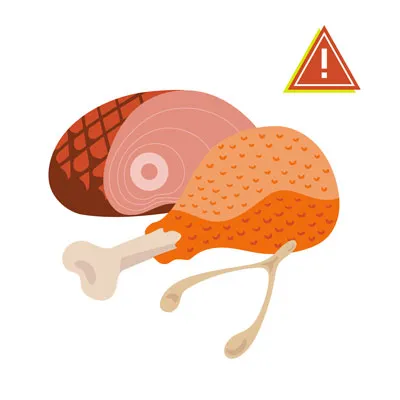 Fatty cuts of meat, including chicken skin and ham, to be avoided for dogs
Fatty cuts of meat, including chicken skin and ham, to be avoided for dogs
Feeding dogs fatty cuts of meat, such as chicken or turkey skin, ham, or heavily marbled beef, can lead to serious health issues. The high-fat content can trigger acute pancreatitis, a painful and potentially life-threatening inflammation of the pancreas. This condition can lead to severe digestive upset, abdominal pain, and systemic complications. Furthermore, while the meat itself might be safe, cooked bones from chicken or turkey can splinter, causing internal damage, obstruction, or even perforation of the digestive tract, which can result in a fatal abdominal infection. Always trim fat and remove bones before offering any meat to your dog.
7. Chocolate
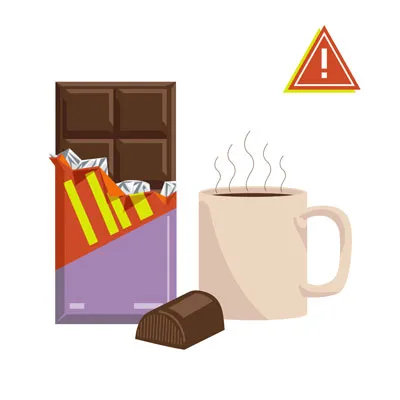 Various chocolate types, emphasizing the high toxicity of chocolate for dogs
Various chocolate types, emphasizing the high toxicity of chocolate for dogs
Chocolate is one of the most well-known and dangerous toxins for dogs, especially during holidays when it’s plentiful in homes. It contains theobromine and caffeine, both methylxanthines that dogs metabolize slowly. The darker and more bitter the chocolate, the higher its concentration of theobromine, making baker’s chocolate and dark chocolate particularly hazardous. Symptoms of chocolate toxicity include hyperactivity, vomiting, diarrhea, excessive thirst, tremors, seizures, abnormal heart rhythms, and in severe cases, pancreatitis or death. Some sugar-free chocolates may also contain xylitol, an additional dangerous sweetener. Any suspected ingestion of chocolate warrants an immediate call to your veterinarian. This information is crucial for any pet owner asking [what can dogs eat and not eat list].
8. Grapes and Raisins
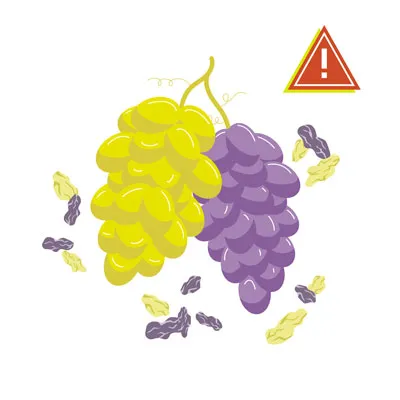 Fresh grapes and dried raisins, indicating their high toxicity for dogs
Fresh grapes and dried raisins, indicating their high toxicity for dogs
Grapes and raisins are highly toxic to dogs and can cause acute kidney failure, even in small quantities. The exact mechanism of toxicity is still not fully understood but is linked to tartaric acid. Even a few grapes or raisins can be enough to wreak havoc on a dog’s kidneys. Symptoms of grape or raisin poisoning include vomiting, diarrhea, lethargy, loss of appetite, abdominal pain, and changes in urination (either increased thirst and urination, or a lack of urine production as kidney function declines). Prompt veterinary attention is critical if your dog consumes these fruits.
9. Macadamia Nuts, Almonds, and Pistachios
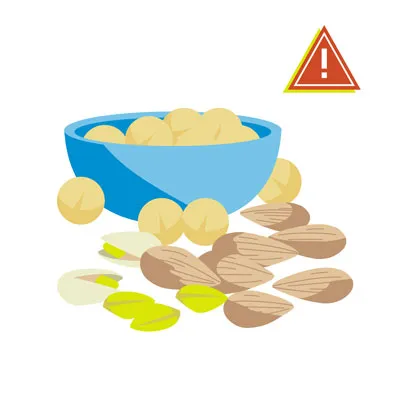 Macadamia nuts, almonds, and pistachios, highlighting their dangers to dogs
Macadamia nuts, almonds, and pistachios, highlighting their dangers to dogs
Macadamia nuts are highly toxic to dogs, causing painful symptoms such as weakness, tremors, depression, vomiting, and hyperthermia (overheating). The exact toxic compound is unknown, but as few as six nuts can cause severe poisoning in a small dog. While other nuts like almonds and pistachios are not as acutely toxic, they pose significant risks. Their high-fat content can lead to pancreatitis, and their hard, often large, shells and kernels present choking hazards or can cause gastrointestinal obstruction or upset if ingested. It is best to avoid all nuts for dogs.
10. Milk & Dairy Products
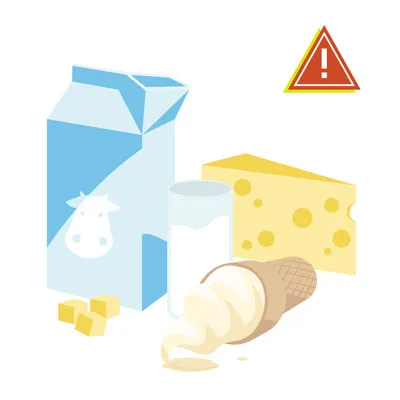 Milk carton and cheese slice, indicating that dairy products should be consumed cautiously by dogs
Milk carton and cheese slice, indicating that dairy products should be consumed cautiously by dogs
Milk and many dairy products can be problematic for dogs. While some dogs can tolerate small amounts, many are lactose intolerant, lacking the enzyme lactase needed to break down lactose. Ingesting dairy can lead to gastrointestinal upset, including diarrhea, gas, and abdominal discomfort. High-fat dairy products like ice cream are also detrimental due to their sugar and fat content, which can contribute to obesity and pancreatitis. Small amounts of low-fat cheese might be acceptable as an occasional treat for dogs without lactose intolerance, but plain, sugar-free alternatives are always safer.
11. Mushrooms
 Assortment of wild mushrooms, cautioning against feeding them to dogs due to potential toxicity
Assortment of wild mushrooms, cautioning against feeding them to dogs due to potential toxicity
It is generally safest to avoid feeding your dog any type of mushroom, especially wild ones. While some commercial white button mushrooms might be considered non-toxic after thorough cleaning and cooking, many wild varieties contain potent toxins that can cause a range of severe symptoms. These include vomiting, diarrhea, neurological issues (hallucinations, tremors, seizures), kidney and liver failure, and even death. Given the difficulty in distinguishing safe from toxic mushrooms, it’s best to err on the side of caution and keep all mushrooms away from your dog.
12. Nutmeg & Cinnamon
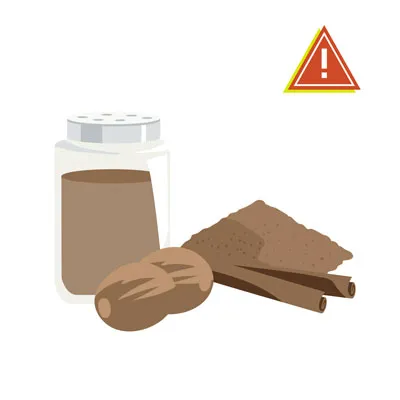 Ground nutmeg and cinnamon sticks, indicating these spices are harmful to dogs
Ground nutmeg and cinnamon sticks, indicating these spices are harmful to dogs
Nutmeg contains myristicin, a compound that can cause hallucinations, disorientation, increased heart rate, high blood pressure, and severe vomiting in dogs, particularly when ingested in large doses or by smaller dogs. Even a small amount of a nutmeg-spiced baked good should be avoided. Cinnamon, while not considered toxic in small quantities, can cause irritation to a dog’s mouth and digestive tract. In larger amounts, it can lead to low blood sugar, vomiting, diarrhea, or changes in heart rate. It’s best to keep both spices out of your dog’s diet.
13. Onions, Garlic, Chives, & Leeks
 Onions, garlic, chives, and leeks, highlighting their toxicity for dogs
Onions, garlic, chives, and leeks, highlighting their toxicity for dogs
All plants belonging to the Allium family, including onions, garlic, chives, and leeks, are highly toxic to dogs. They contain sulfoxides and disulfides, compounds that can damage a dog’s red blood cells, leading to hemolytic anemia. This can manifest as weakness, lethargy, pale gums, rapid breathing, and collapse. Toxicity can occur whether the plants are raw, cooked, dried, or powdered. Onion and garlic powders, often found in processed human foods (even baby food), are particularly potent. Certain Japanese breeds, such as Akitas and Shiba Inus, are especially sensitive. Always check food labels for these ingredients when considering offering human food to your pet.
14. Salt
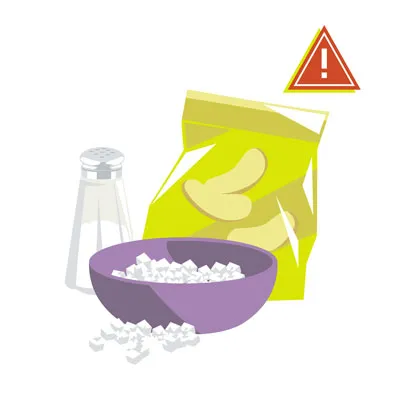 Table salt in a shaker, warning against excessive salt intake for dogs
Table salt in a shaker, warning against excessive salt intake for dogs
While a tiny amount of salt isn’t harmful, excessive salt intake can be very dangerous for dogs. Too much sodium can disrupt the fluid balance in a dog’s cells, leading to sodium ion poisoning. Symptoms include excessive thirst and urination, vomiting, diarrhea, lethargy, tremors, seizures, and in severe cases, kidney damage, coma, or even death. Foods high in salt, such as potato chips, pretzels, processed snacks, and even rock salt used for de-icing, should be strictly kept away from dogs. Always prioritize fresh, plain water for your dog.
15. Spicy Food
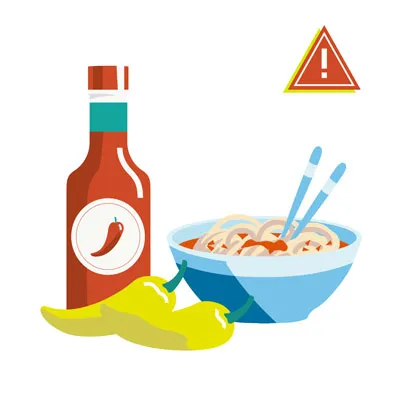 Red chili peppers, cautioning against feeding spicy foods to dogs
Red chili peppers, cautioning against feeding spicy foods to dogs
Spicy foods, containing ingredients like chili peppers, cayenne, or hot sauces, are highly irritating to a dog’s digestive system. They can cause significant discomfort, leading to symptoms such as excessive thirst, drooling, vomiting, diarrhea, and stomach ulcers. While not typically life-threatening unless an underlying condition is present, the pain and distress caused by spicy food are considerable and can lead to expensive emergency veterinary visits. It’s best to keep your dog’s diet bland and free from any spicy additions.
16. Sugar-Free Gum & Candy (Xylitol)
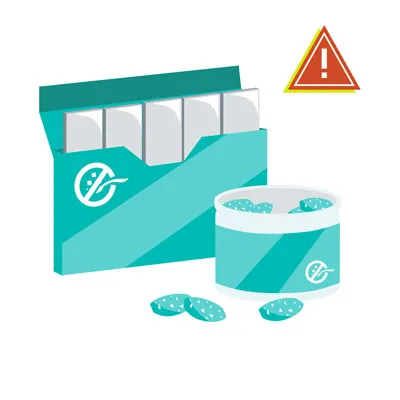 Sugar-free gum and candy, emphasizing the extreme danger of xylitol to dogs
Sugar-free gum and candy, emphasizing the extreme danger of xylitol to dogs
Xylitol is an artificial sweetener found in many sugar-free human products, including gum, candy, mints, peanut butter, toothpaste, and certain baked goods. It is profoundly toxic to dogs. Even small amounts can cause a rapid and severe drop in blood sugar (hypoglycemia), leading to weakness, disorientation, collapse, and seizures. In higher doses, xylitol can cause acute liver failure, which is often fatal. Dog poisoning cases involving xylitol are alarmingly on the rise. Just a few pieces of xylitol-containing gum can be lethal for a medium-sized dog. Always check ingredient labels carefully and keep these products securely away from your pets.
17. Tomatoes & Raw Potatoes
 Tomatoes and raw potatoes, indicating their toxic parts for dogs
Tomatoes and raw potatoes, indicating their toxic parts for dogs
Tomatoes and potatoes fall into a category where some parts are safe, while others are toxic. Ripened red tomatoes are generally safe for dogs in moderation. However, the green parts of the tomato plant, including stems, leaves, and unripe green tomatoes, contain solanine, a glycoalkaloid that is toxic to dogs. Solanine can cause severe gastrointestinal upset, lethargy, weakness, and confusion. Similarly, plain, baked, or boiled potatoes without additives are generally safe in small quantities. But raw potatoes, especially green ones or those with sprouts, also contain solanine and should be avoided. Cooked potatoes are safe; raw are not.
18. Tobacco
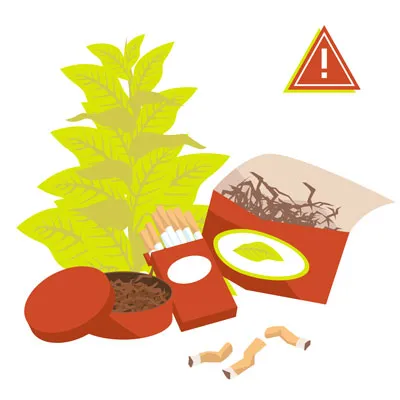 Tobacco products like cigarettes and chewing tobacco, highlighting the severe toxicity of nicotine to dogs
Tobacco products like cigarettes and chewing tobacco, highlighting the severe toxicity of nicotine to dogs
Tobacco, in any form (cigarettes, cigars, chewing tobacco, e-liquids, nicotine patches), is extremely dangerous and unhealthy for dogs due to its nicotine content. Nicotine is a potent toxin that affects a dog’s nervous system. Symptoms of nicotine poisoning can appear rapidly and include vomiting, diarrhea, excessive salivation, rapid breathing, agitation, tremors, weakness, abnormal heart rate, and seizures. More significant or frequent exposure can lead to blue gums, coma, and ultimately be fatal. Dogs are curious creatures and may ingest discarded cigarette butts or accessible tobacco products, necessitating immediate veterinary attention if exposure occurs.
19. Yeast & Raw Dough
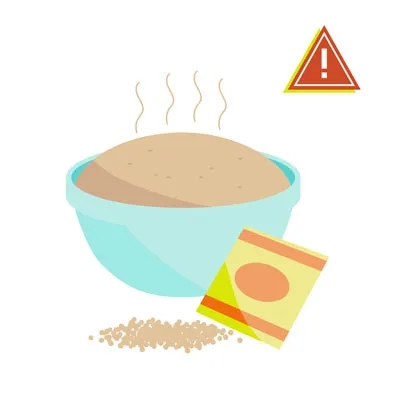 Raw dough rising in a bowl, indicating its danger to dogs
Raw dough rising in a bowl, indicating its danger to dogs
Yeast and raw dough pose a dual threat to dogs. First, the raw dough can expand significantly in a dog’s warm stomach, leading to severe abdominal pain, bloating, and potentially a life-threatening condition called gastric dilatation-volvulus (bloat), where the stomach twists. This requires immediate emergency surgery. Second, the yeast and sugar in raw dough ferment, producing alcohol as a byproduct. This can lead to alcohol toxicity, causing symptoms such as disorientation, weakness, vomiting, tremors, and respiratory depression, which can rapidly become fatal without prompt medical intervention. Never allow your dog access to raw dough.
20. Raw Meat
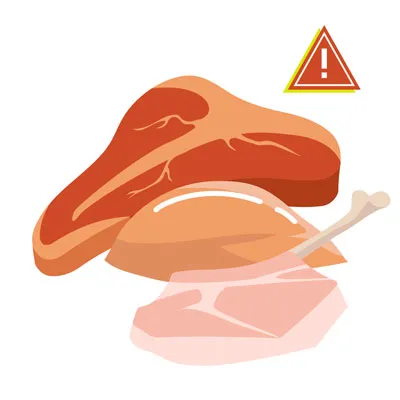 Raw ground meat, emphasizing the risks of bacteria and bones to dogs
Raw ground meat, emphasizing the risks of bacteria and bones to dogs
While some argue for raw diets, feeding your dog raw or undercooked meat carries significant risks. Raw meat can harbor dangerous bacteria such as Salmonella, E. coli, and Listeria, which can cause severe gastrointestinal illness in dogs, as well as posing a risk to human household members through cross-contamination. Furthermore, raw meat may contain parasites. Bones in raw meat, even if uncooked, can still present choking hazards or cause internal damage, splintering, or obstruction in the digestive tract. It is generally safer to feed your dog fully cooked meats without bones or seasoning.
21. Rhubarb
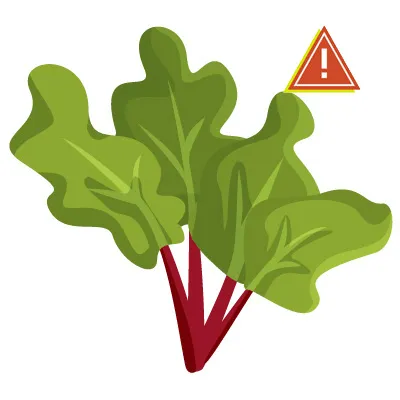 Rhubarb stalks, cautioning against their consumption by pets
Rhubarb stalks, cautioning against their consumption by pets
Rhubarb, commonly used in human desserts, is not safe for dogs. The leaves and, to a lesser extent, the stalks contain soluble calcium oxalate crystals. When ingested in sufficient quantities, these crystals can bind with calcium in the body, leading to a dangerous drop in blood calcium levels (hypocalcemia) and potentially causing acute renal (kidney) failure. Symptoms of rhubarb poisoning include tremors, weakness, excessive drooling, bloody urine, changes in thirst and urination patterns, and vomiting. Keep rhubarb plants and dishes containing rhubarb away from your dog.
22. Star Fruit
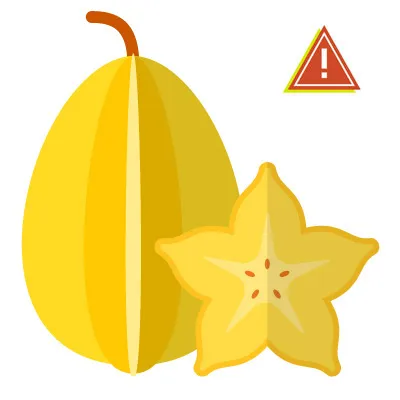 Sliced star fruit, indicating its toxicity for dogs due to oxalate crystals
Sliced star fruit, indicating its toxicity for dogs due to oxalate crystals
Similar to rhubarb, star fruit contains soluble calcium oxalate crystals. These crystals can be harmful to dogs, especially those with pre-existing kidney conditions. Ingesting star fruit can lead to the formation of calcium oxalate stones in the urinary tract, and in larger quantities, can cause acute kidney injury or failure. Symptoms include vomiting, diarrhea, lethargy, increased thirst, and changes in urination. It is best to avoid offering star fruit to your dog as a treat.
23. Flavored Water and Seltzer Water
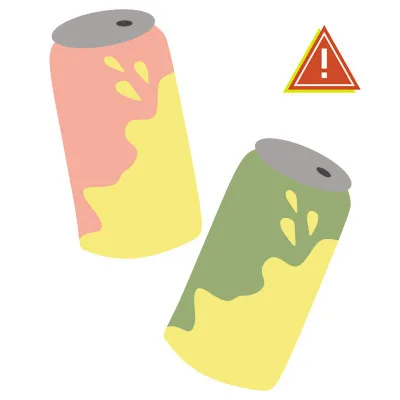 Glasses of seltzer water, warning against flavored or carbonated drinks for dogs
Glasses of seltzer water, warning against flavored or carbonated drinks for dogs
While plain water is essential for your dog’s health, flavored waters and seltzer water should be avoided. Flavored waters often contain added sugars, artificial sweeteners (like xylitol, which is toxic), or other additives that are not beneficial and can be harmful to dogs. Seltzer water and other carbonated drinks can cause gas, bloating, and discomfort for your dog, especially if consumed in large quantities. The fizziness can be startling and unpleasant. Always provide fresh, clean, plain water as your dog’s primary beverage.
Safe & Savory: A Guide to Human Foods Dogs Can Enjoy
While the list of foods to avoid is extensive, there’s also a wide array of [foods your dog can safely eat] that can serve as healthy and delicious treats in moderation. These items can add nutritional value and variety to your dog’s diet when prepared correctly.
1. Apples, Oranges, and Bananas
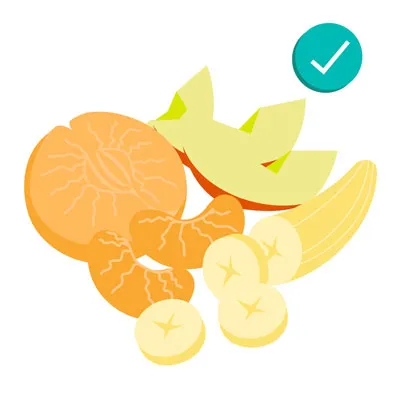 Fresh apples, oranges, and bananas, representing safe fruits for dogs when prepared correctly
Fresh apples, oranges, and bananas, representing safe fruits for dogs when prepared correctly
These popular fruits can be great treats for dogs when prepared properly.
- Apples: A good source of fiber and vitamins A and C. Always remove the core and all seeds, as apple seeds contain cyanide. Cut the apple into small, bite-sized pieces to prevent choking.
- Oranges: Safe in small amounts. Rich in vitamin C. The strong citrus scent might deter some dogs. Remove all peel, seeds, and pith, and offer only the fleshy part.
- Bananas: A good source of potassium, vitamins, and fiber. High in sugar, so offer in moderation. Always remove the peel before giving to your dog.
2. Blueberries and Blackberries
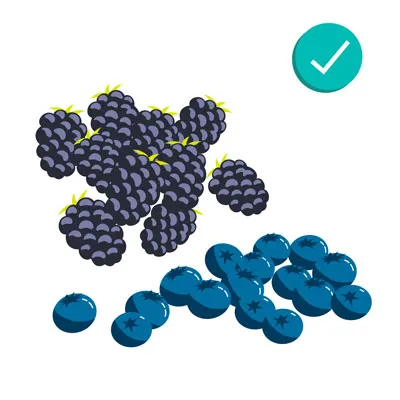 Fresh blueberries and blackberries, indicating their health benefits for dogs
Fresh blueberries and blackberries, indicating their health benefits for dogs
These small berries are packed with antioxidants, fiber, phytochemicals, and vitamin C, making them excellent, healthy treats for your dog. They are low in calories and easy for most dogs to digest. Blueberries and blackberries can be given fresh or frozen, and their small size makes them convenient training rewards.
3. Cantaloupe, Mango, Peaches, Pears, Pineapples, & Watermelons
 Various fruits including cantaloupe, mango, peaches, pears, pineapples, and watermelon, shown as safe for dogs with proper preparation
Various fruits including cantaloupe, mango, peaches, pears, pineapples, and watermelon, shown as safe for dogs with proper preparation
Many other fruits can also be safely enjoyed by dogs, offering a variety of flavors and nutrients.
- Cantaloupe: High in vitamins A and C, as well as fiber. Remove the rind and seeds before offering to prevent choking and digestive upset.
- Mangoes: A sweet treat rich in vitamins. Always remove the large pit, which contains cyanide and can be a choking hazard. Peel the mango and cut into small pieces.
- Peaches: Contain vitamins A and fiber. The pit is a significant choking hazard and contains cyanide, so always remove it completely.
- Pears: A good source of vitamins C and K, and fiber. Remove the core and seeds before serving.
- Pineapples: Full of vitamins, minerals, and fiber. Only offer the fleshy fruit, peeled and cored, in small pieces. Avoid the spiky skin and hard core.
- Watermelons: Mostly water, making it a hydrating treat, especially on warm days. Remove all seeds (even the pale ones from “seedless” varieties) and the rind to prevent choking and digestive issues.
4. Carrots, Cucumber, and Celery
 Fresh carrots, cucumber, and celery stalks, illustrating healthy and safe vegetable options for dogs
Fresh carrots, cucumber, and celery stalks, illustrating healthy and safe vegetable options for dogs
These crunchy vegetables and fruit are fantastic low-calorie options, especially beneficial for overweight dogs.
- Carrots: Excellent for dental health, rich in beta-carotene (Vitamin A), and fiber. Small, bite-sized pieces are ideal.
- Cucumbers: Mostly water, very low in calories, and full of vitamins K, C, and B1. Great hydrating and crunchy snack.
- Celery: Another low-calorie, crunchy treat that can even help freshen a dog’s breath. Contains vitamins A, B, and C. Cut into small pieces to prevent choking on fibrous strands.
5. Cheese
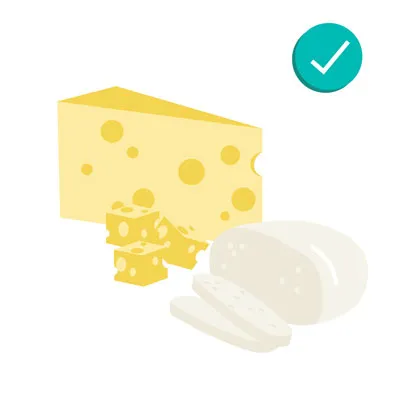 A block of cheese and sliced cheese, indicating moderation and low-fat options for dogs
A block of cheese and sliced cheese, indicating moderation and low-fat options for dogs
While general dairy should be approached with caution, small amounts of cheese can be an acceptable treat for dogs who are not lactose intolerant. Cheese can be a good source of protein and calcium. However, due to its fat content, it should be given sparingly. Opt for lower-fat varieties like mozzarella or cottage cheese as an occasional reward, rather than high-fat options. Always monitor your dog for any signs of digestive upset.
6. Eggs
 Cooked scrambled eggs in a bowl, shown as a safe and healthy treat for dogs
Cooked scrambled eggs in a bowl, shown as a safe and healthy treat for dogs
Fully cooked eggs are a wonderfully nutritious and safe treat for dogs. They are an excellent source of protein, essential amino acids, and vitamins. Scrambled or hard-boiled eggs, plain and unseasoned, can be particularly helpful for dogs with an upset stomach due to their digestibility. Ensure eggs are always cooked thoroughly to eliminate the risk of Salmonella.
7. Peanuts, Peanut Butter, and Cashews
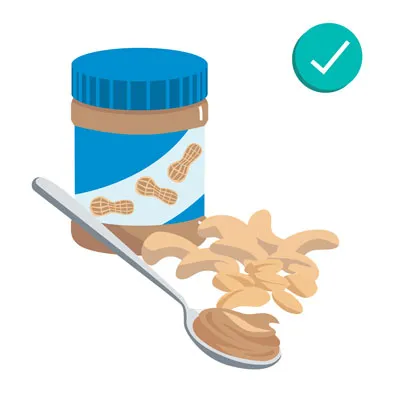 Peanuts, peanut butter, and cashews, highlighting safe nut options for dogs in moderation
Peanuts, peanut butter, and cashews, highlighting safe nut options for dogs in moderation
When given in small quantities and prepared correctly, some nuts can be safe treats for dogs.
- Peanuts & Cashews: Safe for dogs as occasional treats. However, their high-fat content means they should be given sparingly to avoid weight gain or pancreatitis. Always ensure they are unsalted, unseasoned, and unflavored.
- Peanut Butter: A popular dog treat, excellent source of protein and healthy fats. Crucially, always choose unsalted, plain peanut butter and meticulously check the label to ensure it does not contain xylitol, which is highly toxic to dogs. Given in moderation, it can be a great way to administer medication or a simple, delicious reward. For more on this, you might be interested in [what can dogs and cats eat] as well.
8. Popcorn and Corn
 Air-popped popcorn and corn kernels, indicating safe forms for dogs
Air-popped popcorn and corn kernels, indicating safe forms for dogs
- Popcorn: Air-popped, plain, unsalted, and unbuttered popcorn can be a fun, occasional treat. Ensure all unpopped kernels are removed, as they can pose a choking hazard or damage teeth.
- Corn: Removed from the cob, plain corn kernels are safe for dogs. Like popcorn, avoid any added butter, salt, or spices. Corn on the cob, however, is a dangerous choking hazard and can cause intestinal obstruction, so never give the cob to your dog.
9. Coconut and Honey
 Fresh coconut pieces and a jar of honey, indicating their safety for dogs in small amounts
Fresh coconut pieces and a jar of honey, indicating their safety for dogs in small amounts
- Coconut: In small, controlled amounts, the flesh of a coconut (without the furry shell) is generally safe for dogs. Coconut contains lauric acid, which may offer some health benefits, including supporting skin health. However, some dogs might experience mild stomach upset. Avoid coconut water due to its high potassium content, and always remove the hard, fibrous shell to prevent choking or intestinal blockage.
- Honey: In moderation, natural honey is safe for dogs and contains various vitamins, minerals, and antioxidants. It can be a healthy sweetener for homemade treats, but due to its high sugar content, it should be given sparingly to prevent dental issues or weight gain.
10. Shrimp and Fish
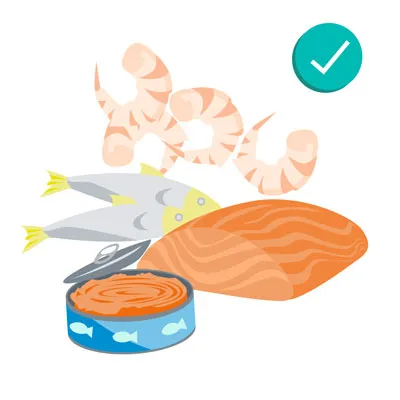 Cooked shrimp and fish fillets, indicating safe seafood options for dogs
Cooked shrimp and fish fillets, indicating safe seafood options for dogs
When prepared correctly, certain seafood can offer excellent protein and omega-3 fatty acids for dogs.
- Shrimp: Plain, fully cooked, de-shelled, de-tailed, and de-veined shrimp can be a fantastic treat. Avoid any seasoned, salted, or buttered varieties.
- Fish: Cooked, plain, and boneless fish such as salmon, sardines, and tuna (packed in water, not oil, and in moderation to limit mercury intake) are excellent sources of protein and beneficial omega-3 fatty acids. Always ensure fish is thoroughly cooked to kill any parasites and remove all bones to prevent choking or internal injury. Fish should be offered no more than twice a week.
11. Turkey
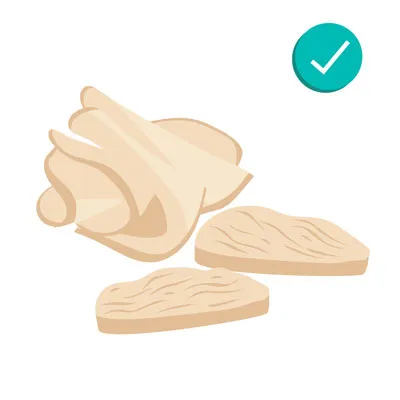 Cooked turkey meat slices, indicating lean, boneless turkey is safe for dogs
Cooked turkey meat slices, indicating lean, boneless turkey is safe for dogs
Plain, cooked turkey meat (without skin, fat, or bones) is a healthy and safe source of protein for dogs. It’s often used in veterinary diets for sensitive stomachs. Ensure it’s unseasoned and unsalted. Small, bite-sized pieces can be a delicious treat. As with chicken, avoid giving your dog cooked turkey bones, as they can splinter and cause internal damage.
12. Grains, Wheat, and Quinoa
 Various grains including wheat and quinoa, indicating their safety for dogs
Various grains including wheat and quinoa, indicating their safety for dogs
Contrary to some popular myths, grains such as wheat, oats, and rice are generally safe and can be a healthy part of a dog’s diet, providing essential carbohydrates for energy and fiber. Quinoa is a particularly nutritious grain, offering a complete protein profile. Ensure grains are cooked plain and offered in moderation. Be observant for any signs of allergic reactions, although true grain allergies in dogs are less common than often perceived.
13. Green Beans
 Fresh green beans, illustrating a healthy and safe vegetable snack for dogs
Fresh green beans, illustrating a healthy and safe vegetable snack for dogs
Green beans are a popular and highly recommended healthy snack for dogs. They are low in calories and packed with vitamins K, C, and A, as well as fiber. Green beans can be served raw, steamed, or from a can (rinsed thoroughly to remove excess sodium), provided they are plain and free from added spices, oils, or salt. Cut them into small, bite-sized pieces to prevent any choking hazards, especially for smaller dogs.
What Dogs Are Most at Risk if They Consume Toxic Foods?
While no dog should ever consume toxic foods, certain factors can make some dogs more vulnerable to severe reactions or complications if they do ingest harmful substances. Understanding these risk factors can help pet owners be even more vigilant.
Age and Size: Puppies, Seniors, and Small Breeds
- Small Breeds: Due to their lower body weight, small dogs are significantly more susceptible to toxicity. A smaller amount of a toxic substance will constitute a higher dose per kilogram of body weight compared to a larger dog, leading to more severe and rapid onset of symptoms. This is particularly true for items like chocolate or xylitol.
- Puppies: Young dogs have less developed digestive systems and immune responses, making them more vulnerable to toxins, bacteria (e.g., in raw foods), and general dietary upset. Their curious nature also makes them more prone to exploring and ingesting inappropriate items.
- Elderly Dogs: Older dogs may have compromised immune systems, slower metabolic rates, or underlying health conditions that make them less resilient to toxins. Their bodies may not process or eliminate harmful substances as efficiently as younger, healthier dogs.
Pre-existing Health Conditions
Dogs with pre-existing health conditions are at an elevated risk. For example, a dog with diabetes may react more severely to sugary or xylitol-containing foods. Dogs with kidney disease will have a harder time processing and eliminating toxins, while those with a history of pancreatitis will be highly sensitive to fatty foods. Always discuss your dog’s specific dietary needs and restrictions with your veterinarian, especially if they have any chronic health issues.
Proactive Protection: Preventing Your Dog from Ingesting Toxic Foods
Accidents can happen, but taking proactive and consistent steps is the best way to minimize the risk of your beloved companion getting into unsafe human food. Prevention is always better than cure when it comes to pet safety.
Secure Storage: Keeping Dangerous Foods Out of Reach
The most effective prevention strategy is to ensure that all toxic foods are completely inaccessible to your dog. Store dangerous items on high shelves, in securely latched cabinets, or in a pantry that your dog cannot open or reach. Remember that dogs are incredibly resourceful and intelligent; if they want something, they will often find a way to get it if it’s within their physical capabilities. Child-proof latches on cabinets can be very effective.
No Table Scraps: Establishing Clear Boundaries
Resist the urge to feed your dog from your plate or offer scraps while you’re cooking. This practice encourages begging and teaches your dog that human food is fair game. It creates a habit that can easily lead to accidental ingestion of harmful foods. It’s safest to only provide treats that are specifically formulated and approved for dogs. If you must give a treat, move away from the table or kitchen area and offer a known safe dog treat.
Educating the Household: Family and Guests
Ensure every member of your household, including children, and any guests, are fully aware of which foods are dangerous for your dog. Clearly communicate that no one should ever sneak food to your dog, no matter how much they beg. Provide a list of forbidden foods and explain the potential consequences. During gatherings, designate a “safe zone” for your dog or keep them supervised to prevent well-meaning but uninformed guests from offering inappropriate treats.
Holiday Hazards: Extra Vigilance During Festivities
Holidays and special occasions are often associated with an abundance of food, many of which can be toxic to dogs. The festive chaos can make it easy for owners to let their guard down. Be extra cautious during these times. Keep platters of food, baked goods, and alcoholic beverages out of reach. Empty trash cans regularly, as discarded food scraps can still be dangerous. Having a clear understanding of [what human food can dogs eat and not eat] is especially critical during these periods.
Emergency Action: What to Do if Your Dog Eats Something Toxic
Despite the best precautions, accidents can still occur. If your dog eats something toxic, your immediate and informed response is critical to their prognosis. Acting quickly and knowing what to do can make a life-saving difference.
Recognizing the Signs of Toxicity
Familiarize yourself with the general symptoms of food toxicity, which can vary widely depending on the substance ingested. Common signs include:
- Vomiting (with or without blood)
- Diarrhea (with or without blood)
- Lethargy or weakness
- Loss of appetite
- Abdominal pain or bloating (stomach may feel hard to the touch)
- Excessive drooling
- Restlessness, hyperactivity, or disorientation
- Tremors or seizures
- Increased thirst or urination, or absence of urination
- Changes in heart rate or breathing patterns
If you observe any of these symptoms, especially after a suspected ingestion, do not delay.
Immediate Steps: Contacting Your Veterinarian or Poison Control
If you suspect your dog has ingested a toxic food, the most crucial step is to seek professional help immediately.
- Call your veterinarian or an emergency veterinary clinic right away. Have their 24/7 emergency contact information readily accessible.
- Contact a pet poison control hotline. Services like the ASPCA Animal Poison Control Center or Pet Poison Helpline are invaluable resources staffed by toxicology experts who can provide specific guidance.
- Be prepared with critical information:
- The type of food or substance ingested.
- The estimated amount consumed.
- The approximate time of ingestion.
- Your dog’s breed, age, weight, and any pre-existing health conditions.
- Any symptoms you have observed.
- The product packaging or a photo of the label if available.
The Importance of Information and Avoiding Self-Treatment
Avoid attempting home remedies or inducing vomiting unless specifically instructed by a veterinary professional or poison control expert. Inducing vomiting can be harmful in certain situations (e.g., if the substance is corrosive, if the dog is already vomiting, or if the dog is lethargic or having seizures), and some remedies can worsen the situation. Timely professional intervention is vital; treatments are typically more successful, and hospitalization may be shorter if a dog receives help quickly.
Conclusion: Empowering Pet Parents for Optimal Canine Health
Navigating the world of human foods for your dog can seem daunting, but armed with the right knowledge, you can ensure your beloved companion enjoys a diet that is both safe and nourishing. From common household toxins like chocolate and xylitol to beneficial treats such as apples and green beans, understanding [what can dogs eat and not eat list] is fundamental to responsible pet ownership.
The commitment to providing high-quality care involves constant vigilance, proactive prevention strategies, and a readiness to act swiftly in emergencies. By storing dangerous foods out of reach, avoiding table scraps, educating your household, and being extra cautious during holidays, you significantly reduce risks. And should an accident occur, knowing how to recognize symptoms and having immediate access to veterinary support is paramount.
Remember, while this guide offers comprehensive insights, it should complement, not replace, professional veterinary advice. Always consult your veterinarian for personalized dietary recommendations or if you have any concerns about your dog’s health or diet. For ongoing support and resources, Dog Care Story is dedicated to helping you make informed decisions for your pet’s well-being. Explore our other articles for more tips on dog health and nutrition, and consider options like pet insurance and a 24/7 vet helpline for unexpected situations, ensuring your furry family member remains safe, healthy, and happy for years to come.
Sources
- “Top 10 dog poisons,” Hilary Parker (5/2023), WebMD, https://www.webmd.com/pets/dogs/top-10-dog-poisons
- “What happens if a dog eats chocolate?” (10/2023), Colorado State University, https://vetmedbiosci.colostate.edu/vth/animal-health/why-is-chocolate-bad-for-dogs/
- “Fruits and vegetables dogs can or can’t eat,” (3/2024), American Kennel Club, https://www.akc.org/expert-advice/nutrition/fruits-vegetables-dogs-can-and-cant-eat/
- “What to do if your dog drinks alcohol,” Jerry Klein (7/2023), American Kennel Club, https://www.akc.org/expert-advice/vets-corner/is-alcohol-dangerous-for-dogs/
- “Can dogs eat apples?” Hector Joy (12/2022), PetMD, https://www.petmd.com/dog/general-health/can-dogs-eat-apples
- “Can dogs eat plums?” Katie Koschalk (7/2023), Chewy, https://be.chewy.com/nutrition-pet-diet-tips-can-dogs-eat-plums/
- “Avocado (Persea spp) Toxicosis in Animals,” Cristine Hayes (9/2024), Merck Veterinary Manual, https://www.merckvetmanual.com/toxicology/food-hazards/avocado-persea-spp-toxicosis-in-animals
- “People foods to avoid feeding your pets,” (n.d.), ASPCA, https://www.aspca.org/pet-care/animal-poison-control/people-foods-avoid-feeding-your-pets
- “People foods dogs can and can’t eat,” (3/2024), American Kennel Club, https://www.akc.org/expert-advice/nutrition/human-foods-dogs-can-and-cant-eat/
- “Can dogs eat nuts?” Amanda Ardente (1/2023), PetMD, https://www.petmd.com/dog/nutrition/can-dogs-eat-nuts
- “Can dogs drink milk?” Sandra C. Mitchell (1/2024), PetMD, https://www.petmd.com/dog/nutrition/can-dogs-drink-milk
- “Can dogs have nutmeg?” Barri J. Morrison (11/2023), PetMD, https://www.petmd.com/nutmeg-safe-dogs
- “Onion, garlic, chive, and leek poisoning in dogs,” Renee Schmid et al. (2024), VCA Animal Hospitals, https://vcahospitals.com/know-your-pet/onion-garlic-chive-and-leek-toxicity-in-dogs
- “Can dogs eat tomatoes?” Anna Burke (10/2024), American Kennel Club, https://www.akc.org/expert-advice/nutrition/can-dogs-eat-tomatoes/
- “Can dogs eat potatoes?” Katherine Ripley (11/2023), American Kennel Club, https://www.akc.org/expert-advice/nutrition/can-dogs-eat-potatoes/
- “What to do if your dog eats a cigarette butt,” (6/2023), American Kennel Club, https://www.akc.org/expert-advice/health/dog-ate-cigarette-butt/
- “Dough & dogs: Why it’s bad and what you can do,” Lisa Goldstein (7/2024), Preventive Vet, https://www.preventivevet.com/dogs/dough-is-toxic-to-dogs
- “Rhubarb,” (n.d.), Pet Poison Helpline, https://www.petpoisonhelpline.com/poison/rhubarb/
- “Can dogs drink carbonated water?” Heather Logue (n.d.), Rover, https://www.rover.com/blog/can-dogs-drink-carbonated-water/
- “What fruits can dogs eat?” Ellen Malmanger (2/2024), PetMD, https://www.petmd.com/dog/nutrition/what-fruits-can-dogs-eat
- “Can dogs have green beans?” Anna Burke (8/2022), American Kennel Club, https://www.akc.org/expert-advice/nutrition/can-dogs-have-green-beans/
- “About pet food safety,” (4/2024), CDC, https://www.cdc.gov/healthy-pets/about/pet-food-safety.html
